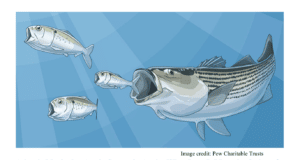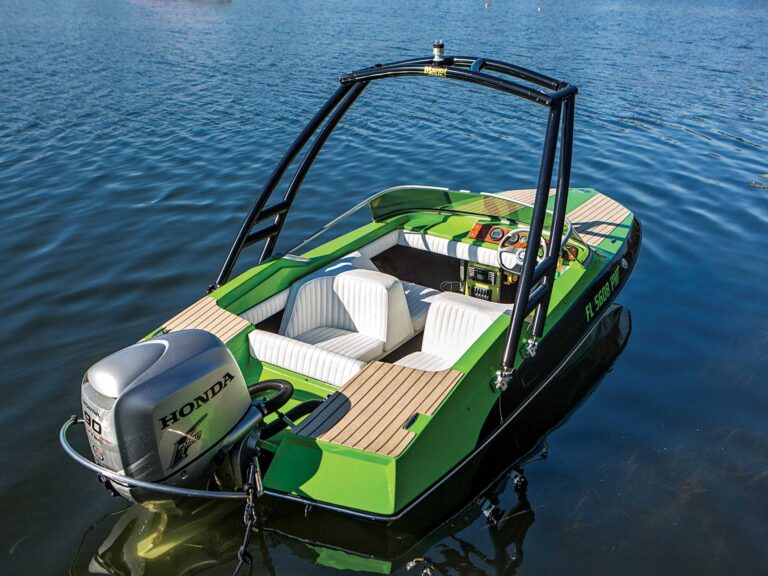Thump-thump. The sound of trailer tires pounding over imperfections in the road was as hurried as it was constant. The workhorses (mud-splotched duallies and oxidized light-duty trucks) headed down a two-lane strip of patchy asphalt to the nearby launch ramps on the morning of the year’s biggest boating day in the Gulf coast town of Crystal River, Florida. Thump-thump. Thump-thump. All the power and know-how of the Southern-tanned drivers would be funneled at daybreak into these common denominators: snorkel masks, fins and comically wide eyes in an open hunt for shells half the size of your palm – and in water barely up to your chest. Our crew of 12, with two boats in tow, joined the conga line in this otherwise sleepy nautical community and thump-thumped to the first moments of a little-known family spectacle known as scallop season.
The first time I’d heard the word “scalloping” used as a verb came just two months earlier when a friend proposed our families “do it.” Do it? What’s to do? Bay scallops, I knew for a fact, were thimble-size pieces of white meat piled up in the seafood case at the grocery store. Like the ice cubes on which they sit, scallops stirred in me little curiosity. But then we idled our 30-foot Regal alongside a twin-engine center console toward the confluence where the spring-fed river and salt-rich Gulf waters mesh into a rare ecosystem. A rush of smaller boats sprinted past us.
Down in the cabin three kids short of 6 years old pressed faces into the windows and watched the open water grow. Then, three miles out, from above and belowdecks we saw in the distance off to port a congregation of boats so thick that they appeared on the horizon as cities do in America’s flatlands. Must have been at least 300 of them anchored in three feet of water. Farther out was a loose cluster of 100 more. I remembered what Dr. Bill Arnold, a research scientist for Florida Fish and Wildlife, told me earlier that week:
“It will be insane out there. Anyone with a boat, a mask and a $13 fishing license can do it.”
We motored closer. The indiscriminate definition of “scalloping” began to unfold. There were keg-bellied men and petite women, grandpas and 5-year-olds. They were all in schools, hovering face down on the water’s surface and using their flippers to counter the current. We shifted our gazes from snorkelers to the view directly over the gunwale: a field of long, manicured sea grass in three to four feet of window-clear water. Blades floated to the surface, as if they’d just been mowed. Somewhere in the underwater landscape lay bucket loads of booty. White gold. Scallops.
_**Next>>**_
[pagebreak]
Our captain, Crystal River native Chris Spindler, deftly positioned what had to be the biggest boat on the water over a wide patch of vegetation and flipped the windlass switch to employ the anchor. Up went the red and white dive flag.
“It isn’t the spot I’d pick for the most action,” he said, wiping beads of sweat from his forehead in the heavy air, “but the depth should be good for the kids.”
Having never so much as seen a live scallop, I’d called on three experts in the days leading up to this moment. Keith Miritello, an officer with Florida Fish and Wildlife, told me bay scallops are usually found in groups, that they cling to the grass above the Gulf floor as protection against bottom-patrolling crabs and octopi. Dr. Arnold explained how the little guys are native to pockets of U.S. coastal waters, that they live only one year and will either be plucked by human hands or be crushed by saltwater predators. (This helped explain the carpets of broken shells found on Gulf beaches.) Then there was 66-year-old John “Ski” Szafranski, a retired professional diver who’s gone deep off the coasts of Scotland, Venezuela, Kuwait, Russia and Australia. He was out here, somewhere.
“I’ve done it 47 years, and I still look forward to scallop season as much as anything else I do,” Ski told me. “The meat’s good, but it’s the hunt that keeps me coming back.”
One by one we jumped from boat to water to do it. As we belly-coasted on the water, our masks turned the bay to a giant aquarium. The turtle grass billowed in the path of an incoming tide, as if caught in a slow-motion breeze. Pompano fry darted through the vegetation. Everything turned dead quiet. And there, within five feet of the Regal’s swim platform, I saw one – I thought. A slightly open bivalve, shaped like the Shell gas symbol. Around the edges of the opening were strands of tiny blue Christmas lights – its eyes. As I slowly reached out against the moving water, he closed his shell and ducked two inches deeper into the grass. The magnification underwater convinced me to spread out my hand wide to grab it, when in fact two fingers and a thumb would do the job.
“Is this what we’re looking for?” I asked Spindler, raising the plunder at the boat.
“That’s it.” He held out a mesh bag to keep the first catch of the day fresh. (It would take 199 more over a heap of pasta to make dinner for four.)
A worried voice emerged from the picture of success: That of 4-year-old Noelle, flippers on but still working up the nerve to slip from the swim platform to the water.
“Don’t take them all, Daddy!”
She thought I’d picked the Gulf clean.
_**Next>>**_
[pagebreak]
Fact is, this stretch of water just below the coastline famously known as Florida’s “Big Bend” is a sanctuary for bay scallops. Their numbers fluctuate year to year because they’re so sensitive to changing weather. Scallop season had to be closed in 2003 when biologists found fewer than five scallops per 600 square meters.
“In 2000 we were getting 250 to 300 scallops in a sample area, and people were picking their limit in knee-deep water,” said Arnold. “We’re back up to 48 per sample, which is a good number but not great.”
Still, no place in the world produces such large numbers of bay scallops, as the sold-out hotels and backed-up boat ramps give witness. This is because dozens of freshwater springs empty into the Crystal, Homosassa and Steinhatchee Rivers, which in turn flow into the Gulf. The clean water and the filtering action of the grass beds make an ideal habitat for manatees and these ornamental jewels. Commercial harvesting is illegal, leaving the entire take to recreational boaters during a three-month summer spree.
This is a problem to some of the red-blooded locals. The heartbeat of scalloping sits off U.S. 19, a six-lane artery that connects Tampa from the south to the fishing villages near the state’s panhandle, catching Crystal River directly between modern Florida and old Florida. The waterfront economy is held together by the nuclear power plant and dozens of no-frills dive shops. For some, long-established habits die hard here.
“There are factions of people,” said Galvin Oakes at the Homosassa Riverside Resort, “who don’t want the word about scalloping to get out. They won’t outright lie, but they might be evasive, trying to hold on to what they think is theirs.” Roughly 72 hours before our rendezvous in Crystal River, I’d asked an employee at a dive center how bountiful the scallop harvest would be on opening day. “Not very,” he said. “I’m not sure why, but we haven’t had any scallops for two years.” Try as they might to shake the hunters, the old-town natives are as unsuccessful as the scallops themselves. “There’s one!” yelled 5-year-old Jacqueline, her huge mask dripping salt water.
“I found four right there,” responded 12-year-old Amy, holding two handfuls.
The mesh bag, growing weightier, was emptied into a cooler of ice. The cold surroundings make the shells open just enough to ease the job of shucking later.
“Twenty minutes,” said one of the men in our group, challenging another to an official scallop-off. “We’ll see who comes back to the boat with the heavier bag.”
Game on.
_**Next>>**_
[pagebreak]
Nobody had to wander more than 20 feet from either of the two boats, each of us pulled into a perpetual Easter egg hunt with moving targets. As the shadow of a human would close in on it, a scallop would scoot away, using its edible adductor muscle to quickly open and close the shell for propulsion. Pull one out of the water and it’s usually clapping, loudly.
“Ahh! You little … aah!” One of them slammed its trapdoor onto the flesh of my palm. It was more shocking than painful, but worse, I’d forgotten that everything out of my mouth was flowing through the snorkel tube and could be heard clearly above water.
“One get you?” asked Spindler, laughing in the boat’s aft cockpit.
At that moment there were 10 of us slowly prowling the water, our ages ranging from 4 to early 50s. Three people would scour the same patch of turtle grass, and a fourth would come along to find a cagey scallop tucked in deep. The action was spread just enough to keep everyone fully engaged. Morning sneakily turned to afternoon.
“Got five more,” said 38-year-old Lenore, standing in the water with her face masked up like a little girl’s in the kiddy pool. She proudly dropped the loot in her bag before pushing her face to the water and returning to the search with the rest of the kids.
Dressed for Success, Sr.
Expensive dive gear would be laughable for scalloping. This is all our adults used, and even this was on the cusp of going overboard.
Gladiator Spring Suits Some of the adults chose to wear these, not as protection from the 80-some degree water but as a shield against possible jellyfish. We chose this model because as a 2 mm shorty it isn’t too bulky for warmer weather, and the price fit our budget. Essentials: $59.99, overtons.com
DiveMaster Fins One adult started the scallop hunt without fins, and found himself being pushed around by the current. The fins helped to pinpoint positions before diving. The slots on these fins allow water to flow through for less physical effort. Essentials: $19.99, overtons.com
DiveMaster Snorkel and Mask My, what big eyes and lips you have. Forget vanity with snorkel gear – go for comfort. The soft silicone around the cheeks, nose and mouth made this kit easy to use all day. Essentials: $39.99, overtons.com
Dressed for Success, Jr.
The act of gearing up to snorkel turns up the thrill meter for kids. The only mistakes we could have made would have been spending too much or picking the wrong colors.
Stearns Youth Shorty The water was so warm we decided to go slightly loose with the wetsuits instead of tight. Stearns uses a Glide Skin neckline to reduce chafing, but it was the pink trim that made all the difference. Essentials: $39.99, stearnsinc.net
Java Mask, Snorkel, Fins Watch a 4-year-old enter the underwater world for the first time with a mask and snorkel. Whoa! The adjustability of all this gear was a huge help. We scored the entire set, plus a mesh dive bag for less than $30. Essentials: $26.99, westmarine.com
Best Spots Under the Top
Let’s say you won’t be going to Australia, Hawaii or Tobago this summer. With snorkel gear and a boat, you can still find an amazing underwater story in these three locations.
Florida Keys Shallow-water snorkeling in the Keys is as good as it gets in the United States. The highlight is a two-day mini-lobster season (July 30-31 this year), an all-comers event scheduled a week before the regular lobster season, which depletes the lobster population.
Lake Tahoe It’s a deeper body of water, but visibility of more than 100 feet is the best of any inland lake in America, and makes the simple act of floating on your belly with a dive mask an unforgettable experience.
Northern Michigan Water clarity and sandy bottoms make for the best snorkeling, and using those criteria the lakes near Traverse City are among America’s best. The fish won’t glow in the dark as they do in salt water, but a salt-free swim can be a plus.









